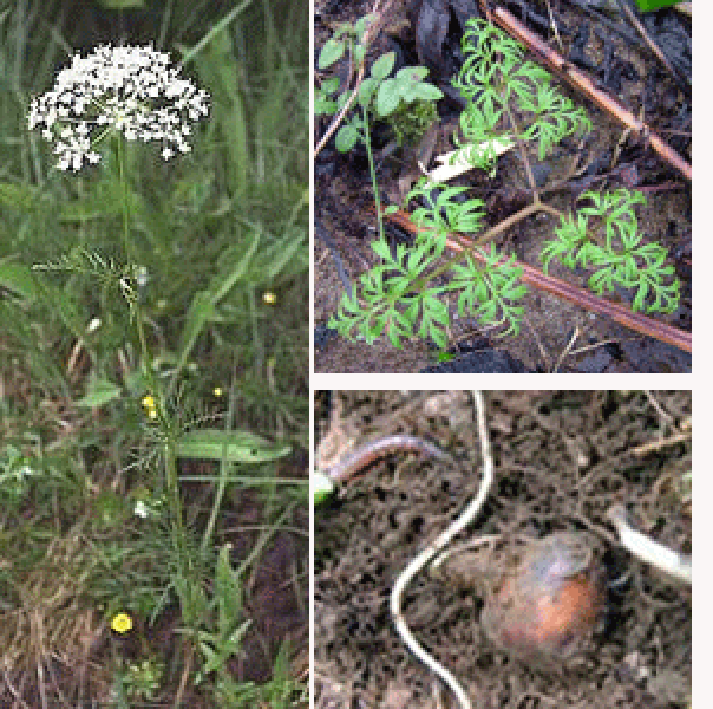 Mature pignut plant, young pignut plant and grubbed-up pignut.
Mature pignut plant, young pignut plant and grubbed-up pignut.
Welcome to the summary page for FabulousFusionFood's Cook's Guide entry for Pignut along with all the Pignut containing recipes presented on this site, with 1 recipes in total.
This is a continuation of an entire series of pages that will, I hope, allow my visitors to better navigate this site. As well as displaying recipes by name, country and region of origin I am now planning a whole series of pages where recipes can be located by meal type and main ingredient. This page gives a listing of all the Pignut recipes added to this site.
These recipes, all contain Pignut as a major wild food ingredient.
The pignut (Conopodium majus) is a slender perennial of the umbelliferae (carrot) family. It has an erect, slightly-ridged stem that grows from between 25cm up to 74cm (though on average it will be about 40cm high). It has pinnate leaves (two or three paired leaflets and a terminal leaflet all derived from a common stem) which are generally more delicate than the leaves of other members of this family. In common with other members of this family the plant bears a large number of small flowers bourne on unbels (umbrella-like structures of stalks). It is fairly common in grass verges, open woodland, sandy heaths and rough grassland and tends to prefer slightly acid soils, though it is common through most of the British Isles.
The plant (when grown from seed) develops a brown tuber at its root, which is edible and tastes something like a nutty parsnip. In the past the pignut used to be grubbed up by pigs and people alike, and my mother recalles grubbing it up to eat as a child, though the practice now seems to have died out. The pignut itself is anout the size and shape of a shelled hazelnut (see image, above) but it cannot be pulled up as the stem will snap. Rather, one has to use a knife or a finger to follow the root underground to discover the tuber. The pignut itself has a thin skin that can easily be scraped away to reveal the white flesh inside. This can be eaten raw or can be boiled in the same manner as parsnips.
Like most wild flowers you shouldn't really go around grubbing-up pignuts. Rather you should collect the seed and plant them in your own garden. Take note that if you're not certain of what a pignut looks like it can resemble toxic plants such fools' parsley Aethusa cynapium and hemlock Conium maculatum. However, these days you can can source seeds for this plant from a wildflower nursery such as Nickys Nursery Ltd. If you grow these yourself you will be certain that what you have is the pignut (though no other plant generates tubers like pignuts).
This is a continuation of an entire series of pages that will, I hope, allow my visitors to better navigate this site. As well as displaying recipes by name, country and region of origin I am now planning a whole series of pages where recipes can be located by meal type and main ingredient. This page gives a listing of all the Pignut recipes added to this site.
These recipes, all contain Pignut as a major wild food ingredient.
The pignut (Conopodium majus) is a slender perennial of the umbelliferae (carrot) family. It has an erect, slightly-ridged stem that grows from between 25cm up to 74cm (though on average it will be about 40cm high). It has pinnate leaves (two or three paired leaflets and a terminal leaflet all derived from a common stem) which are generally more delicate than the leaves of other members of this family. In common with other members of this family the plant bears a large number of small flowers bourne on unbels (umbrella-like structures of stalks). It is fairly common in grass verges, open woodland, sandy heaths and rough grassland and tends to prefer slightly acid soils, though it is common through most of the British Isles.
The plant (when grown from seed) develops a brown tuber at its root, which is edible and tastes something like a nutty parsnip. In the past the pignut used to be grubbed up by pigs and people alike, and my mother recalles grubbing it up to eat as a child, though the practice now seems to have died out. The pignut itself is anout the size and shape of a shelled hazelnut (see image, above) but it cannot be pulled up as the stem will snap. Rather, one has to use a knife or a finger to follow the root underground to discover the tuber. The pignut itself has a thin skin that can easily be scraped away to reveal the white flesh inside. This can be eaten raw or can be boiled in the same manner as parsnips.
Like most wild flowers you shouldn't really go around grubbing-up pignuts. Rather you should collect the seed and plant them in your own garden. Take note that if you're not certain of what a pignut looks like it can resemble toxic plants such fools' parsley Aethusa cynapium and hemlock Conium maculatum. However, these days you can can source seeds for this plant from a wildflower nursery such as Nickys Nursery Ltd. If you grow these yourself you will be certain that what you have is the pignut (though no other plant generates tubers like pignuts).
The alphabetical list of all Pignut recipes on this site follows, (limited to 100 recipes per page). There are 1 recipes in total:
Page 1 of 1
| Iron Age Pork and Beans Origin: Ancient |
Page 1 of 1